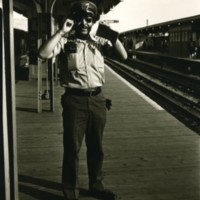Browse Exhibits (1 total)
The Howard El Project-1985

This is a photographic collection by Elizabeth Morris, drawn from her student work at Columbia College Chicago, 1982-1987. During these years, Ms. Morris worked in black & white, and used multiple silver gelatin, negative formats; 35mm, 2.25 x 2.25, and 4 x 5.
The Howard El Project photographs depict a fascination with portraiture and, social documentary photography. This small collection is of educational interest to researchers studying clothing, identity, and ethnicity in Chicago during the 1980's. Details of clothing, hair, and even manner expressed in these portraits are of interest to photographers, social scientists, historians, and costumers. This digitization project makes available a snapshot of Chicago culture, for institutions focused on Chicago cultural heritage.
Ms. Morris took photographs over a five-week period, in April and May of 1985, on the CTA Howard St. elevated train platform in Rogers Park, and produced a collection of 35 images for her View Camera class final. The Howard St. station is a transfer point for people going to and from Chicago. The project was conceived to be an opportunity to approach a wide variety of people in a real-life setting, during Friday afternoon rush hours, using a 4 x 5 view camera as a starting point for conversions, that would lead to strangers posing for a portrait.
Ms. Morris secured permission from CTA staff to set up her camera on a platform facing South, and put down a piece of masking tape for subjects to stand on. After getting a subject to stand, she went under a black cloth to focus the lens, emerged to engage the subject, pulled the flap on the film holder, and then used a long cable to depress the shutter. After the image was taken, the flap was re-inserted to protect the exposure. The challenge was to approach total strangers, gain their trust within a few moments, as well as carry out the technical work of working with a view camera.
Working with a view camera involves many steps done by hand. The photographer must load and remove the film into holders in total darkness. Developing the negatives is done in hand held processing tanks, filled with various chemicals, in specific time frames. If there is too little developer, the temperature is too warm or cold, or the tank is shaken too hard, the film can receive permanent damage that is visible when printing the images, some of Ms. Morris’s prints reflect these types of technical struggles. All negatives were printed as contact prints, reflective of their true film size, on a tinted silver gelatin coated Agfa paper. There was no formal agreement of rights with the subjects, other than a verbal agreement not to sell their image for commercial purpose. The final project was presented on five mats cut with seven windows each, mimicking train cars and their windows.